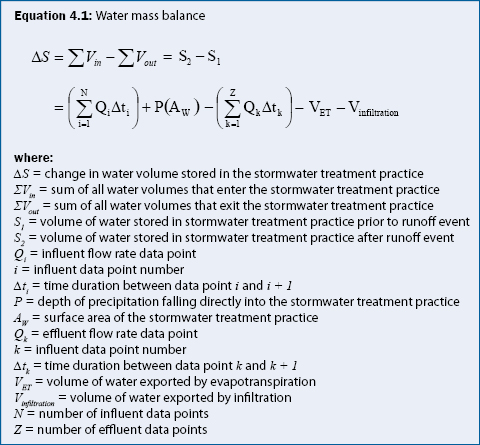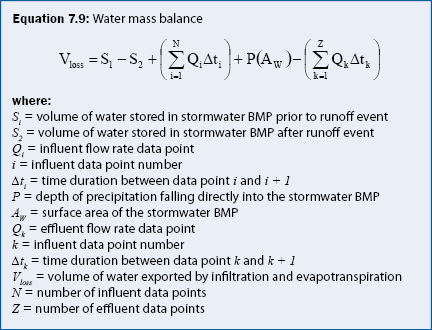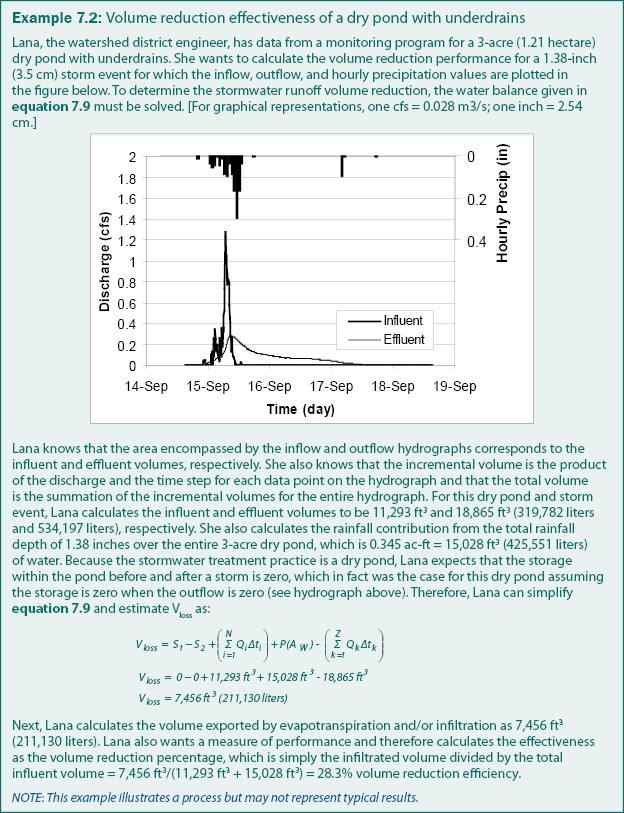
Assessment of volume reduction
A.J. Erickson, P.T. Weiss, J.S. Gulliver, R.M. Hozalski
When monitoring a stormwater treatment practice, one assessment goal may be to determine the reduction in runoff volume due to the stormwater treatment practice. This assessment goal may be achieved by a water budget analysis on the stormwater treatment practice, (see Water Budget Measurement). This section provides water budget recommendations and an example of a water budget analysis as it pertains to a monitored stormwater treatment practice.
In order to perform a water budget, the discharge of all open channel and conduit flow entering and exiting the stormwater treatment practice must be recorded as a function of time. Also, if direct rainfall, evapotranspiration, or infiltration are significant (> 5% of water budget), the volume must be measured or estimated (see Water Budget Measurement for techniques). A water balance for a typical stormwater treatment practice is given in equation 4.1 (repeated here from Water Budget Measurement).

The volume of water contained within a stormwater treatment practice can be determined from the water depth (see Water Budget Measurement for water depth measurement) if the stormwater treatment practice surface geometry (or bathymetry) is known. Water depth measurements can usually be stored on the same data logger as flow rate, precipitation, and other data. Otherwise, water depth must be recorded manually during site visits just prior to and immediately after a runoff event.
The most direct assessment of volume reduction is achieved by measuring all the components in equation 4.1 while ensuring that the mass balance of water is satisfied (i.e., ΔS = ΣVin - ΣVout). In theory, the volume exported by evapotranspiration (VET) and infiltration (Vinfiltration) can be summed to determine the volume reduction. It is often difficult and costly, however, to measure all water budget components, especially the volume lost to evapotranspiration and infiltration. Therefore, the common practice is to measure the initial and final storage values and the other terms in equation 4.1 and then solve equation 4.1 for the net sum of the volume exported by evapotranspiration and infiltration (VET + Vinfiltration = Vloss), as given in equation 7.9.

Although the Vloss term in equation 7.9 contains the volume of runoff lost through infiltration and evapotranspiration, the losses due to evapotranspiration are small and can be assumed to be zero if the duration of the runoff event is small (i.e., a few days or less). Thus, the Vloss term in equation 7.9 is an estimate of the volume of stormwater runoff that has been infiltrated by the stormwater treatment practice and can be used to estimate the runoff volume reduction performance as demonstrated in example 7.2.

Continue to Assessment of pollutant removal.